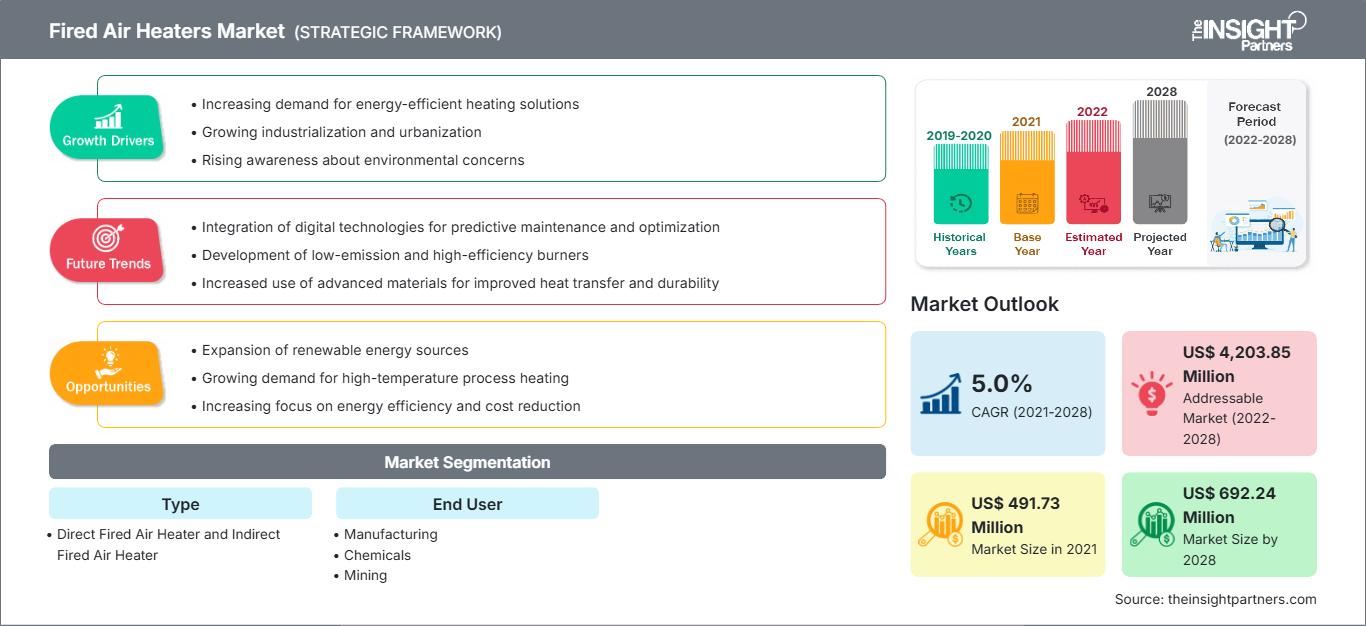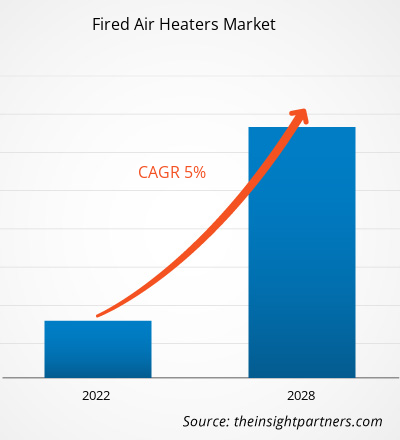Se espera que el mercado de calentadores de aire a fuego crezca de US$ 491,73 millones en 2021 a US$ 692,24 millones en 2028; se estima que crecerá a una CAGR del 5,0% entre 2021 y 2028.
El aumento de la demanda de equipos de calefacción para aplicaciones industriales en países emergentes es un factor clave para el mercado de calentadores de aire a fuego. Esta demanda se debe al aumento de la demanda energética de empresas en economías emergentes como China, India, Japón y Brasil. Además, debido a su corto tiempo de arranque, alta eficiencia y fiabilidad, la demanda de calentadores de aire a fuego en la fabricación, la generación de energía y el procesamiento ha aumentado. Asimismo, el aumento de la inversión en capacidad de generación de energía es otro factor clave para los calentadores de aire a fuego. Gracias a décadas de desarrollo en la tecnología de producción de productos, la demanda de calentadores de aire a fuego continúa creciendo significativamente.
Los calentadores de aire a fuego se utilizan comúnmente en la industria de procesamiento para calentar gases o líquidos a una temperatura específica. Además, la integración del internet de las cosas (IoT) en estos calentadores incrementaría su adopción, impulsando el crecimiento del mercado durante el período de pronóstico.
Obtendrá personalización en cualquier informe, sin cargo, incluidas partes de este informe o análisis a nivel de país, paquete de datos de Excel, así como también grandes ofertas y descuentos para empresas emergentes y universidades.
Mercado de calentadores de aire a fuego: Perspectivas estratégicas

- Obtenga las principales tendencias clave del mercado de este informe.Esta muestra GRATUITA incluirá análisis de datos, desde tendencias del mercado hasta estimaciones y pronósticos.
Impacto de la pandemia de COVID-19 en el mercado de calentadores de aire a fuego
La pandemia de COVID-19 ha afectado significativamente al mundo y continúa devastando a varios países. Hasta el brote de COVID-19, la industria de calentadores de aire a combustión experimentaba un crecimiento sustancial en términos de producción. Desafortunadamente, la pandemia ha diezmado la demanda de calentadores de aire a combustión en diferentes industrias a nivel mundial, lo que se refleja en volúmenes de pedidos significativamente menores entre los fabricantes de aeronaves, lo que resulta en una menor producción. La disminución en los volúmenes de producción afectó negativamente a los negocios de varios fabricantes de componentes y tecnologías asociadas. Además, el debilitamiento de los usuarios finales, como las industrias de la construcción, la automoción y la minería, desanimó al mercado. Por lo tanto, los negocios de los actores del mercado de calentadores de aire a combustión se han visto gravemente afectados por la desestabilización de la producción. Durante la propagación del virus COVID-19, toda la industria de la construcción se paralizó con recursos mínimos para prever el futuro. Varias unidades de producción en EE. UU., Francia, Rusia y China se suspendieron temporalmente para cumplir con las normas gubernamentales de confinamiento y distanciamiento social. Los actores de la construcción experimentaron una reducción del 20% al 30% en la demanda de nuevos proyectos. Además, la paralización de los proyectos de construcción en curso debilitó aún más el mercado. Este factor afectó negativamente al mercado de calentadores de aire a fuego.
Perspectivas del mercado de calentadores de aire a fuego
Aumento de la demanda de equipos de calefacción para aplicaciones industriales
Las calderas, bombas de calor y hornos son equipos de calefacción industrial que se utilizan en las industrias química, alimentaria, de la construcción, minera y otras para llevar a cabo procesos de producción. Una caldera es un recipiente cerrado en el que se calienta agua u otro líquido y se forma vapor, que posteriormente se utiliza para impulsar máquinas al dispensarse a alta presión. Además, una bomba de calor es un dispositivo que transfiere calor a zonas cálidas o frías. Los hornos son componentes esenciales de un sistema de calefacción central. En los rehervidores de amina y glicol, los gases corrosivos de sulfuro de hidrógeno y dióxido de carbono deben eliminarse del vapor de hidrocarburos antes de que los respectivos combustibles puedan almacenarse o introducirse en el gasoducto en la refinación de gas natural y petróleo crudo. Al igual que el vapor de gas natural, el glicol se utiliza para eliminar el agua del gas natural antes de su distribución. Debido a su bajo mantenimiento y simplicidad, este tipo de calentador se utiliza en los sectores del gas natural, el petróleo crudo y el procesamiento. En el sector de procesos químicos, los calentadores a fuego se utilizan comúnmente para calentar fluidos de proceso y generar vapor.
En la mayoría de los casos, los calentadores de combustión consumen la mayor cantidad de energía en la industria de procesos. Para esta investigación, se utiliza un calentador tipo caja con tubos verticales para calentar un fluido de hidrocarburo. Los calentadores de elución, una aplicación especializada de los calentadores de aire a combustión que requiere un diseño distintivo y único, se utilizan en la industria minera. La elución es el proceso de extracción de un material mediante lavado con un disolvente, casi siempre con la adición de calor, en química analítica y orgánica. Minerales como el oro se extraen mediante intercambiadores. Una solución de mineral y disolvente circula por un lado del intercambiador y un fluido transmisor de calor, comúnmente fluido térmico, se distribuye por el otro. En la industria alimentaria, especialmente en los trenes de fritura (patatas, snacks y precocinados), se utilizan calentadores de fluido caloportador, en los que circula fluido térmico que se calienta en el equipo y su calor se transfiere al aceite que fríe los productos mediante un intercambiador. Se han realizado algunas instalaciones similares al proceso de elución en la minería, donde el aceite de fritura circula directamente a través de la caldera, que posteriormente se utiliza como calentador de aire a combustión. Los calentadores de combustión directa se utilizan ocasionalmente como calentadores de fluidos de transferencia de calor o como calentadores indirectos en la industria petroquímica. El buen funcionamiento del servicio de mantenimiento de los calentadores de combustión directa en plantas químicas y refinerías, así como la uniformidad en la disponibilidad de repuestos, son las principales razones de su adopción, ya que los calentadores de fluidos de transferencia de calor son reconocidos por sus ventajas en sus funciones específicas. Por lo tanto, el aumento de la demanda de equipos de calefacción para diversas aplicaciones industriales está impulsando el mercado de los calentadores de aire a combustión.
Perspectivas del mercado basadas en tipos
Según el tipo, el mercado de calentadores de aire a combustión se ha segmentado en calentadores de aire de combustión directa y calentadores de aire de combustión indirecta. Los calentadores de combustión directa proporcionan un medio seguro para calentar entornos industriales al mantener una proporción adecuada de aire a combustible, ya sea gas natural o propano. El gas se suministra directamente al quemador en un calentador de combustión directa, mientras que la corriente de aire proporciona el oxígeno necesario para la combustión. El gas se mezcla con el aire que pasa a través del deflector del quemador. El quemador está configurado para quemar en tándem y en paralelo al flujo de aire. El consumo de combustible y los gastos de funcionamiento se reducen, ya que aproximadamente el 100 % del combustible se convierte en calor.
Perspectivas regionales del mercado de calentadores de aire a fuego
Los analistas de The Insight Partners han explicado detalladamente las tendencias regionales y los factores que influyen en el mercado de calentadores de aire a fuego durante el período de pronóstico. Esta sección también analiza los segmentos y la geografía del mercado de calentadores de aire a fuego en América del Norte, Europa, Asia Pacífico, Oriente Medio y África, y América del Sur y Central.
Alcance del informe de mercado de calentadores de aire a fuego
| Atributo del informe | Detalles |
|---|---|
| Tamaño del mercado en 2021 | US$ 491,73 millones |
| Tamaño del mercado en 2028 | US$ 692,24 millones |
| CAGR global (2021-2028) | 5.0% |
| Datos históricos | 2019-2020 |
| Período de pronóstico | 2022-2028 |
| Segmentos cubiertos | Por tipo
|
| Regiones y países cubiertos | América del norte
|
| Líderes del mercado y perfiles de empresas clave |
|
Densidad de actores del mercado de calentadores de aire a fuego: comprensión de su impacto en la dinámica empresarial
El mercado de calentadores de aire a fuego está creciendo rápidamente, impulsado por la creciente demanda del usuario final debido a factores como la evolución de las preferencias de los consumidores, los avances tecnológicos y un mayor conocimiento de los beneficios del producto. A medida que aumenta la demanda, las empresas amplían su oferta, innovan para satisfacer las necesidades de los consumidores y aprovechan las tendencias emergentes, lo que impulsa aún más el crecimiento del mercado.

- Obtenga una descripción general de los principales actores clave del mercado de calentadores de aire a fuego
Los actores del mercado de calentadores de aire a fuego adoptan estrategias como fusiones, adquisiciones e iniciativas de mercado para mantener su posición en el mercado. A continuación, se enumeran algunos avances de los actores clave:
- En 2018, Allmand Bros. Inc., un productor de 80 años de equipos portátiles para sitios de trabajo de alto rendimiento y una subsidiaria de Briggs & Stratton Corporation, amplió sus instalaciones actuales en Holdrege, NE, para aumentar la capacidad de fabricación y la velocidad de comercialización con nuevas tecnologías.
- En 2018, Pirobloc, líder en el diseño y fabricación de calentadores de aceite térmico, abrió una filial en EE. UU. Pirobloc USA ya es una realidad y está en pleno funcionamiento.
El mercado mundial de calentadores de aire a fuego se ha segmentado de la siguiente manera:
Mercado de calentadores de aire a fuego: por tipo
- Calentadores de aire de combustión directa
- Calentadores de aire de combustión indirecta
Mercado de calentadores de aire a fuego: por usuario final
- Fabricación
- Productos químicos
- Minería
- Almacenes
- Petróleo y gas
- productos farmacéuticos
- Otros
Mercado de calentadores de aire a fuego: por geografía
- América del norte
- A NOSOTROS
- Canadá
- México
- Europa
- Alemania
- Francia
- Italia
- Reino Unido
- Rusia
- Resto de Europa
- Asia Pacífico (APAC)
- Australia
- Porcelana
- India
- Japón
- Corea del Sur
- Resto de APAC
- Oriente Medio y África (MEA)
- Sudáfrica
- Arabia Saudita
- Emiratos Árabes Unidos
- Resto de MEA
- América del Sur (SAM)
- Brasil
- Argentina
- Resto de SAM
Perfiles de empresas
- ALLMAND BROS., INC
- Corporación Exotherm
- Hastings HVAC, Inc.
- Pirobloc, SA
- SIGMA THERMAL, INC
- Stelter & Brinck, Ltd.
- Industrias Tamarack
- Dinámica térmica
- Wacker Neuson SE
- Zeeco, Inc
- Análisis histórico (2 años), año base, pronóstico (7 años) con CAGR
- Análisis PEST y FODA
- Tamaño del mercado, valor/volumen: global, regional y nacional
- Industria y panorama competitivo
- Conjunto de datos de Excel
Informes recientes
Informes relacionados
Testimonios
Razón para comprar
- Toma de decisiones informada
- Comprensión de la dinámica del mercado
- Análisis competitivo
- Información sobre clientes
- Pronósticos del mercado
- Mitigación de riesgos
- Planificación estratégica
- Justificación de la inversión
- Identificación de mercados emergentes
- Mejora de las estrategias de marketing
- Impulso de la eficiencia operativa
- Alineación con las tendencias regulatorias






















 Obtenga una muestra gratuita para - Mercado de calentadores de aire a fuego
Obtenga una muestra gratuita para - Mercado de calentadores de aire a fuego